Where I live, in Kittsee, we have fantastic apricots. Apparently we are the apricot capital of Austria in competition with some place in Tirol. That’s great – apricots are delicious. Kittsee is also a Dandelion (Slovak “pupava”, German “Löwen zahn”) paradise, which is not so good. I don’t mind a mixed lawn but the dandelions would take over completely if one doesn’t do something about them.
When I first purchased my home, I tried taking the dandelions out with a pickaxe as the initial set were pretty big, and it’s what I had on hand. I used the first class pickaxe to remove a bamboo infestation left over from the previous owner; removing 60 metros of underground horizontal pipes is a serious job. I’ve since bought a fancy Fiskars 7870 weeder that ladies like, but it’s far too slow for my taste. Speed comes as hand tools are applied vigorously. On top of that the fancy Fiskar weeder is also next to useless in stony soil. Plus, there’s a lot of plastic in the design which makes the Fiskars weeder not much fun to use: it feels like fluorescent lights and plastic toys.
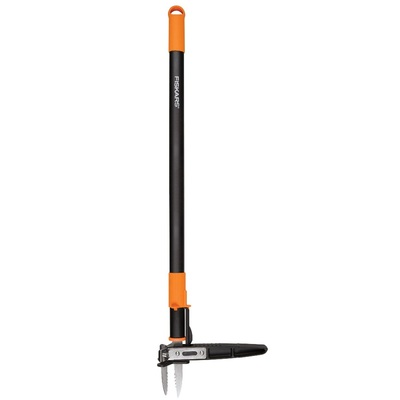
Fiskars 7870 Uproot Garden and Lawn Weeder
I’ve used a traditional weeding trowel to great effect. Inevitably poorly made modern weeding trowel bend (which they do all the time as I’ve been through three of them) and become useless. This last time I’ve decided to try to find something better. I know my local Landhaus only offers weak weed trowels and pickaxes, so a local search was a waste of time.
I threw “weeder” into German Amazon (neat trick: the English query will pull up a bunch of dual labeled items and then, you have the exact translation next to a picture; text dictionaries are next to useless for tools). Something interesting came up: a Cape Cod weeder.

Krumpholz Cape Cod Weeder
Now I don’t know whether a Cape Cod weeder is any good, and there aren’t any reviews at Amazon.de, so I look at “Cape Cod weeder” in Google and find an Amazon.com listing and a more obscure little website called RedPigTools.com. Some guy making and forging tools at ridiculously high prices (try 5x the price of your local garden supermarket).
But Bob Denman has an amazing selection of reasonably solid (they could be even heftier to my taste) hand made tools, specifically in weeders. Were I in their shipping zone, despite the outrageous prices I would be ordering between three and five of the following items right now.

Exotic Handmade Weeders
The Red Pig Tools website is useful even to someone who cannot possibly buy Bob’s tools.
How have Bob and Rita accomplished with their site?
- First, they are focused. This website sells hand made garden tools (not just any tools).
- Second, they don’t undervalue their product. While they are pricier than others, site visitors immediately recognize this company does not mix good quality with bad quality.
- Third, they respect their site visitors and tempt search engines by offering valuable, detailed information. The Denman’s give very detailed descriptions of each item, encouraging confidence that one is ordering the right thing and hence, likely receive larger orders, as well as return orders.
- Finally, they are very personable with being too personal. We don’t need to know about the state of their marriage, or a struggle with anti-depressants, and the Denmans aren’t telling. But there’s a personal voice in all the writing and a photo of Bob with Rita’s arms around him. There’s a short description of Bob’s life, which allows the bourgeois gardeners who buy such expensive tools to identify with him and even make him somewhat aspirational (Bob dropped out of the advertising rat race to build a barn and make hand-made tools: those early years in marketing really paid off though).
How could they improve the site?
I would expect that Red Pig tools is a multi-million dollar business with very healthy margins. It’s all run off Prostores.com, a slightly outdated Content Management System (CMS). The photos aren’t even all that big (you might want to fix that Bob). However, the Denmans enjoy top rankings and lots of traffic, despite bad image URLs, and not particularly good URL structure (Bob if you find this and would like some help moving to a much more SEO friendly WordPress store, drop me a line: I will trade handmade code and design against handmade garden tools).
This, ladies and gentleman, is how you do e-commerce and build a name for yourself online on the cheap. Start by being useful.
One of the advantages of a useful website is you can get free links which other people have to pay for (if they can get them at all). Bob is not a client of ours but he is getting a first class link and write up for free. We don’t accept guest posts at Foliovision, but if we did the market price for a write up like this would about $250 and $600 including links with targeted anchor text.
Thanks for teaching me about weeders Bob. Below you will find an assortment of my favorite weeders with Bob’s writeup.
Hand Weeders Gallery
A gallery of Red Pig Tools weeders for posterity: you never know when even the most well run site will disappear.

Crevice Weeder
The most difficult weeding job is to extract plants that take root in the narrow crevices between bricks or in sidewalk cracks. This tool has a thin but strong blade that slips deep into cracks (As deep as 3″) and drags the weed out by its roots. The blade is not sharpened and therefore does not cut the roots, leaving them to throw more growth.

Ball Weeder
A Victorian invention, Ball Weeders have a two pronged fork protruding from a 2 1/2-inch diameter knob at the base of a short handle. While effective at prying taprooted weeds such as dandelions, they are also useful for removing weeds with spreading roots. The ball is an excellent fulcrum that gives you leverage even when the ground is soft or wet. Weeders with narrow, straplike fulcrums penetrate soft, wet surfaces and fail to give leverage. Our Ball Weeder has a full 10 inches of shaft and handle above the ball, giving a many fold increase in mechanical advantage. The forged head is strong enough and long enough to grab mature taproots by the shoulder and pop them out of the ground with ease.

Grampa Weeder
One of the simplest, easiest to use, stand up weeding tools is the Wrench now being marketed by an Oregon company as “Grampa’s Weeder.” Invented back in 1913, the Weed Wrench was once produced in a number of variations by a variety of manufacturers. (I have one in my collection produced in the 1930’s in Riverside, California.) Today there’s just one version and, fortunately, it’s a very good one. The tool consists of a cast iron head on the end of a three foot long wood handle. The head is essentially a 2-prong fork with an L-shaped, 2 pronged foot pad lever riveted to it. You center the 4 prongs over a weed, press your foot on the footpad and push the weeder into the ground. As the lever hits the ground the prongs grip the weed’s roots tightly. You lean the handle towards the footpad and, “Pop,” out comes the weed, root and all.

Two Tine Hand Weeding Fork Jekyll Weeder
Gertrude Jekyll (1843-1932) is firmly ensconsed in the pantheon of great gardeners. Her opus, Home and Garden, first published in 1900, contains chapters on TheWorkshop and The Kinship of Common Tools and includes a tender paean to the pleasure of wielding an old, worn spade. Her favorite weeder was a short handled, two tine fork now commonly called a “Jekyll Weeder”. Overall, the tool is about a foot long. It penetrates soil easily and is used to pry, twist and extract the most stubborn weeds.

Weed Yank
This is a light duty weeder and cultivator of my own design, although I wouldn’t be surprised if someone, somewhere, sometime in the past had come up with the same thing. To use this tool, you just swing it so that the curving tines enter the ground just on the far side of a weed. Then jerk. Out comes the weed, roots and all. While this isn’t the tool for overgrown, deeply rooted weeds — the direct pull requires too much strength — it’s fine for the little weeds.

Weeding Fork Long Handle
Before the era of chemical weeding, when slicing, prying and yanking were the weed removal methods of choice, weeding forks were the big guns. Sometimes called spade forks, these tools were used to pry overgrown, tap-rooted perennial weeds such as dandelions, docks and thistles. If you live on rural acreage and eschew Round-Up, Crossbow and other weed killers, this is your tool

Cape Cod Weeder
Designed decades ago by a woman living on Cape Cod (or so it was told). The cape cod weeder was a regional favorite until the late 1980’s when Snow & Neally of Bangor, Maine began to market it nationwide. It is now well on it’s way to ubiquity. Our version adheres closely to the orginal design albeit with a longer shank and shorter handle. We also forge it a bit thicker for longer life and better performance on overgrown weeds. The tool cuts on both the forward and back stroke — it’s a scuffle hoe — and can be turned on its side and driven in by its point to nick out weeds snuggled up to valuable plants. Properly made, the cape cod weeder has a slight back angle to the blade that makes it exceptionally effective on the pull stroke.

Alec Kinnear
Alec has been helping businesses succeed online since 2000. Alec is an SEM expert with a background in advertising, as a former Head of Television for Grey Moscow and Senior Television Producer for Bates, Saatchi and Saatchi Russia.

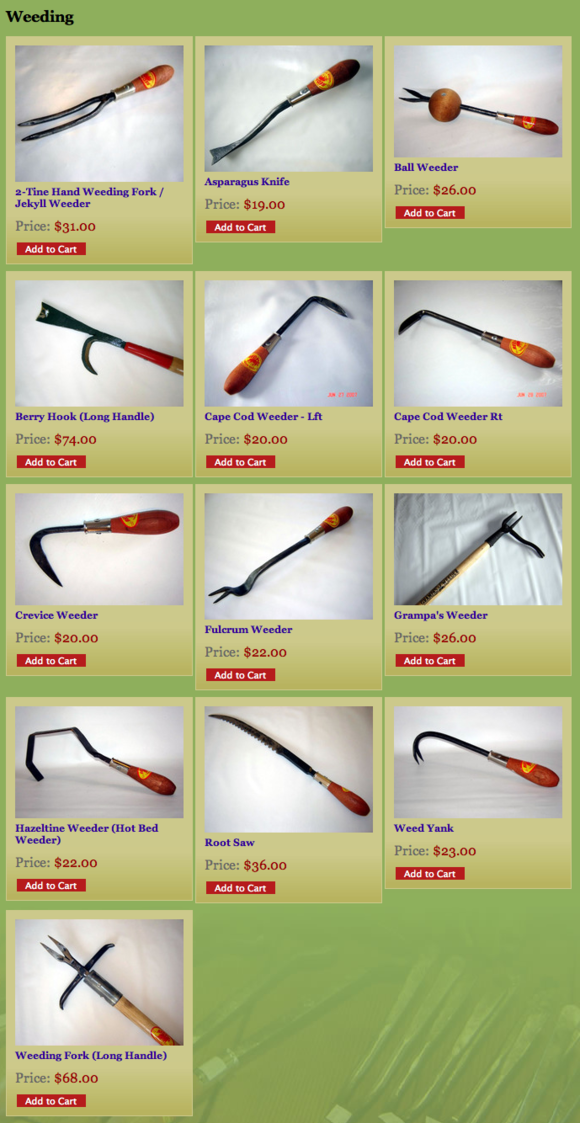
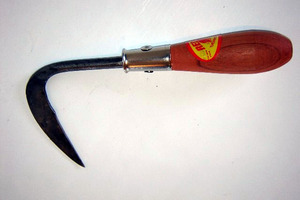
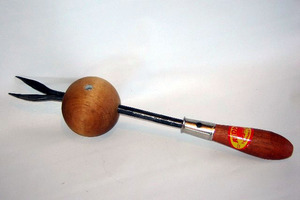
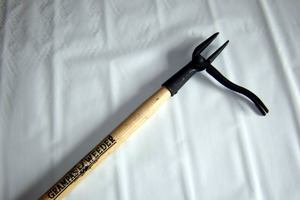
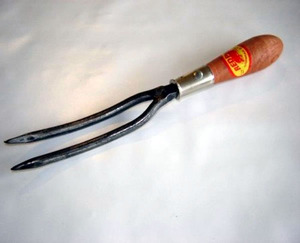
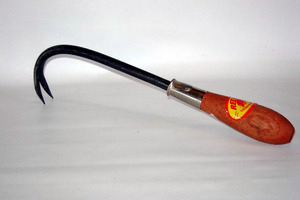
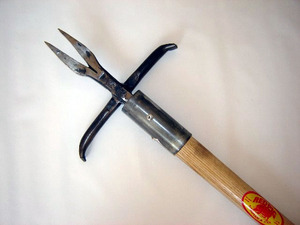
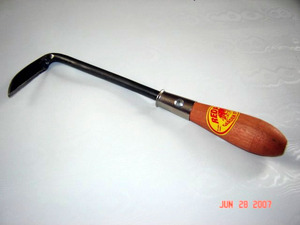
Alec,
Just came across this posting, nearly a year after you put it up. Thank you for the kindness of your words and for the link.
While we are making a living , we are by no stretch of the imagination a multi-million dollar business. We are a blacksmith, his wife, a 21 year old young woman apprentice and an assortment of chickens, horses, cats and a wonderful Sussex spaniel making tools for people who want something that will last for generations instead of weeks.
We forge some 250 different tools in all and are working to get all of them on the website before this year is out.. I wrote the descriptions while recovering from a shattered knee last year. I forge tools. I write. A hammer, a pencil and a ballpoint pen are nearly the limit of my technological prowess. As for the computer, I e-mail, compose documents, perform simple searches and watch videos on Youtube…that’s it.
If you will let me know what tools you need the most, I would like to send you some as thanks. As for trading handmade code for handmade tools, I would consider it if I had any notion of what URL structure and codes and such were all about. Alas, I don’t.
By the way, I stumbled upon your post while searching for the name of the original designer of the Cape Cod weeder. I’m afraid it is lost to history. However, it is a variant on a Prussian hoe popular in England in the 1850’s and invented, I assume, in Prussia some years before.
I might have found your post sooner but I have made it a policy not to look up my name on the internet. I did so one time and, of course, came across other Bob Denmans. One was a fellow whoposted that he had cut off his own penis with a knife, having always wanted to be “smooth” in his nether region. He was searching for someone to help him finish the job he had so brutally begun. In another post he described how he had finished the task and was thoroughly emasculated. I don’t know whether he had help or finished the job by whittling away himself. At that point I decided that I would never again search the internet for Bob Denman or Red Pig Tools. I don’t know what I might find, but I know that I am quite happy not knowing things that I don’t want to know.
All the best,
Bob Denman
Hi Bob,
Great to hear from you. I’m still weeding here. I reduced my Dandelion population in 2013 to about 1/5 of what it was in 2012. 2014 should be the year to get rid of them completely.
After bending several simple half tube trowel weeders in less than an afternoon, finding Fiskars far too slow, I finally moved back to a simple half spade with rim for your boot and a short handle. The best dandelioning technique I’ve found is putting the blade in straight down about two inches from the root and opening the soil. With the soil open, you can then just pull the giant dandelion all the way out. Sort of a surgical approach: first you cut the patient open and then take out the tumor.
This is a technique best suited to men (putting a spade deep in and out of solid earth a few hundred times is a fair workout).
The crevice weeder and the weeding fork still look awesome. I do worry the weeding fork wood or blade would break against mature dandelions (one inch thick stems). I did destroy even one of my spades last year fighting with bamboo (previous owner; bamboo was disposed of in 2012 with just a few lingering surprises in high summer 2013 – lawn is still recovering from the sixty feet trenches dug to get it all out).
Your story about other Bob Denmans is surreal. I can understand why you decided to spend less time on the internet. If I weren’t building the tools for the internet myself, I’d rather spend less time there myself. While communication at the speed of light is fantastic, as a culture we are losing much time for reflection and the gift of deeper concentration. I’m working hard on making myself read more serious literature again.
I’ll drop you an email as well.
I also have some of the Red Pig Tools. I found the site somehow, probably by a search. And I once lived west of Portland, OR, so I had some familiarity with the area. (Mostly I’m Californian, moved there in 1956 as a child, returned in 1970, then two years in overcast Oregon.)
I started with the wide digging trowel, a “heavy hand hoe” (the one they label “Now that’s a hoe!”) and the essential Cape Cod weeder. (It replaced my Snow and Neally CC weeder.)
BTW, you say their prices are higher, but the Euro price of the CC weeder you list is higher than what Red Pig is charging. And the Red Pig tools are quite a bit heftier.
(They also have a kind of blackened-iron appearance, with slag marks or whatever causes the variations. Very appealing. Not at all like a sheet of stainless steel, as so many of the tools are these days (if not plastic! Shudder!).
About a year later I ordered 3 more pieces, including a narrow trowel and a weeder. And a few days ago (May 2014) I ordered an Abbott weeder, a narrow crow’s foot tiller, and a 3-pronged fork.
After roughly hacking or picking out a planting area, with large tools and much work, I tend to do my gardening by sitting on a bucket lid and using short hand tools. (My favorite stand-up weeding tool is a “stirrup hoe,” also called an oscillating hoe or a “hula hoe.” The ones I use now are Swiss-made, with a replaceable blade (I’ve worn a couple out to just a smidge of steel left!). I got the from Steve’s Seeds, but a search should turn them up. The working head is painted red.
For my sit-down gardening, I favor the Red Pig tools. Which ride around in the bucket I then sit on.
These are great tools. Heirloom quality, though I hope not to worry about that for a while. I buy what appeals to me because one never knows when they won’t be being made….
–Tim May, Corralitos, CA (between Santa Cruz and Monterey, but inland)
Hi Tim,
Thanks for the report. I’m doing most of my weeding with a sharp spade these days. Do you happen to have a link or name for the Swiss-made tools. Over here in Europe, they should be affordable.
Alec,
The Swiss company is Glaser Engineering. The Product web page is here:
glaser-swissmade.com/englisch/products.html
Some other companies sell the Glaser stirrup hoe head with an ash handle which is easily attached. I misspoke when I said it was Steve’s Seeds, as it was actually Johnny’s Selected Seeds. Here’s the page for the stirrup hoe I have:
johnnyseeds.com/p-5496-5-stirrup-hoe.aspx
I’m sure there will be sellers local to you.
–Tim
Hi Tim,
Thanks for the links. That stirrup hoe only cuts the top of the weed off (perhaps half an inch under the earth) leaving the root. How does that work for getting rid of the weeds long term?
My two most common weeds are dandelion and thistle here in Burgenland.
Yes, the stirrup/oscillating/Hula hoe cuts near the surface. Basically, like the Cape Cod Weeders or other shallow hoes. This works fine for maintaining garden beds, where the weeds or unwanted seedlings are small and with shallow roots. As one of the sites mentions–I think the Glaser one–by the time a weed is showing, it’s already too late. The idea being to “scuffle” the bare areas with a shallow hoe many times. The long hoe is good for using in a mode where one pushes/pulls in a forward direction, sort of like with a push broom in a large factory area. One is not supposed to bend over at all, nor to use it for really thick or tough weeds.
For the very thick or tough weeds, this is what the various “weed wrenches” and tools with pivots are for. You and Bob discussed this, with your sharp spade being your preferred tool.
I was not suggesting the stirrup hoe as a substitute for the hard work of removing a deep and thick root of a weed. (Although I have certainly abused my Glaser stirrup hoe by chopping at thick weeds, by yanking, and by generally not just doing the more gentle back and forth! A couple of blades have worn down to just thin sections, but probably because of hitting rocks and too many sharpenings with a file.)
On my own property, poison oak (poison ivy on the U.S. east coast, poison sumac in other places, no idea what form it may take in Europe) is invasive over large areas. It has a long root, much like an oak root, and will re-sprout from the root. So my yard worker and I use a heavy mattock (pick, with a blade) to cut the root as far back as possible. This often stops the re-sprouting, as the energy to get back to the surface and resume photosynthesis is just not there.
The same thing happens with milkweed, thistles, and hemlock. Cut them off at the ground enough times and they just don’t come back.
A fun little blog you have here. Again, I really like excellent tools. For hand-forged, functional tools, the Red Pig tools are a good deal.
Thanks for the weeding tips, Tim. I’ve only been at it for a few years (apart from childhood of course), so your real life experiences is a great help.
I think the “once you can see it, it’s too late” is a bit pessimistic. I did manage to successfully pull out 60 metres of bamboo runs, though the mature dandelions are very resilient.
Thank you for the tips, I couldn’t help but notice that there are similar handcrafted garden and weeding tools at sustainableseedco.com. Seikouba and Kusakichi are the two main brands that they carry but these Red Pig weeders look great too. I think I might give them a try!
I have enjoyed reading all the articles and I wanted to ask a question and see if anyone can tell me how to get rid of Bamboo. I bought a house that has it and I am cutting it but don’t know how to get rid of it, Please help if you can thanks.
Hi Susie,
You have to dig up all the bamboo by hand. It will take a couple of years to get it all. Our lawn still has not recovered from the enormous digging that I did when getting rid of the bamboo which came with our house.